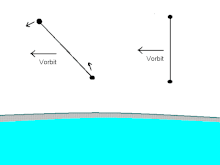Our website is made possible by displaying online advertisements to our visitors.
Please consider supporting us by disabling your ad blocker.
Skyhook (structure)

A skyhook is a proposed momentum exchange tether that aims to reduce the cost of placing payloads into low Earth orbit. A heavy orbiting station is connected to a cable which extends down towards the upper atmosphere. Payloads, which are much lighter than the station, are hooked to the end of the cable as it passes, and are then flung into orbit by rotation of the cable around the center of mass. The station can then be reboosted to its original altitude by electromagnetic propulsion, rocket propulsion, or by deorbiting another object with the same kinetic energy as transferred to the payload.
A skyhook differs from a geostationary orbit space elevator in that a skyhook would be much shorter and would not come in contact with the surface of the Earth. A skyhook would require a suborbital launch vehicle to reach its lower end, while a space elevator would not.
Previous Page Next Page


